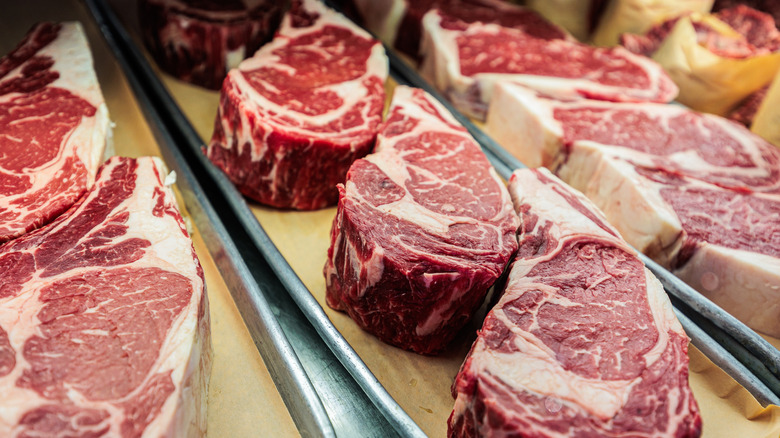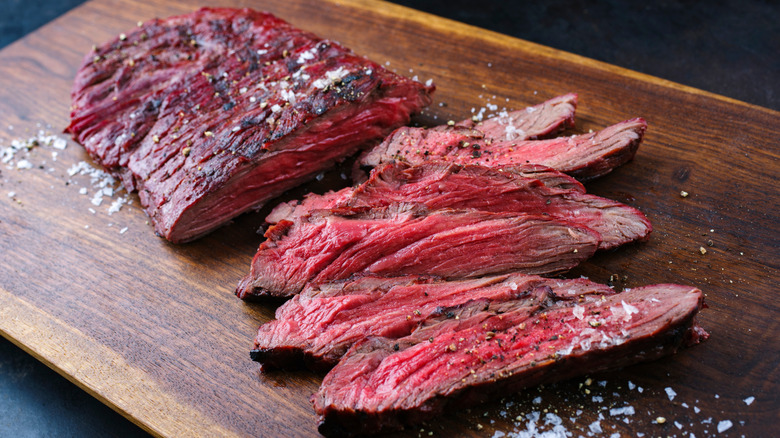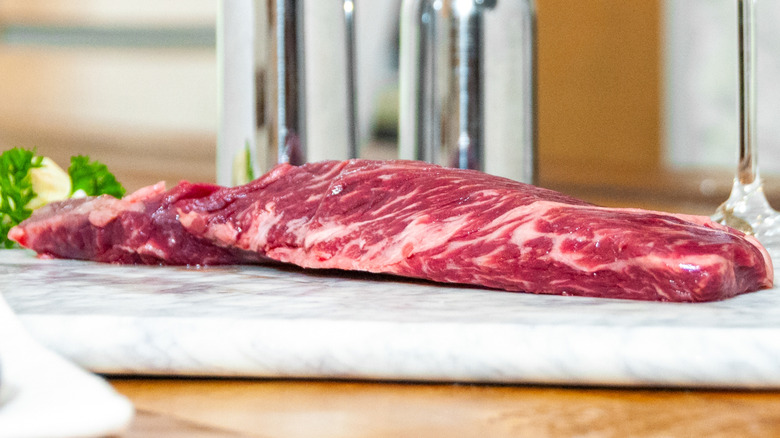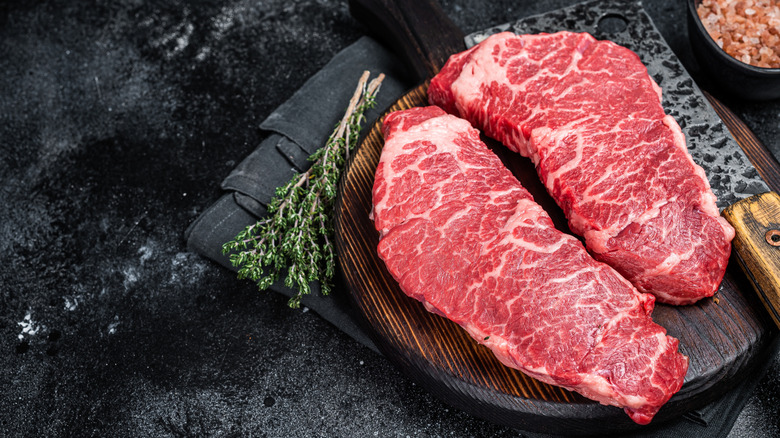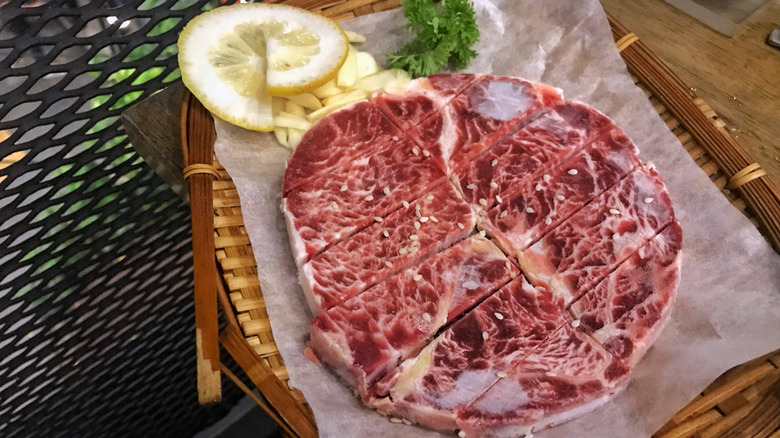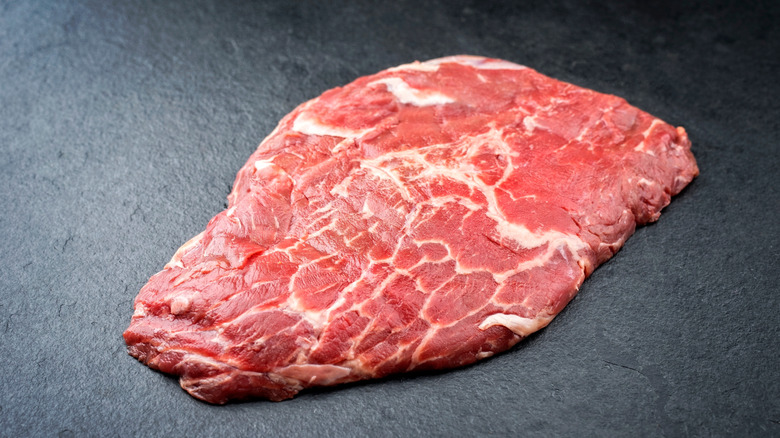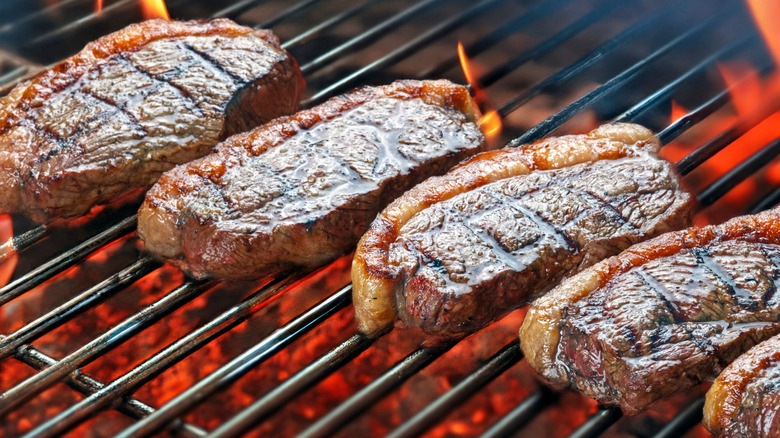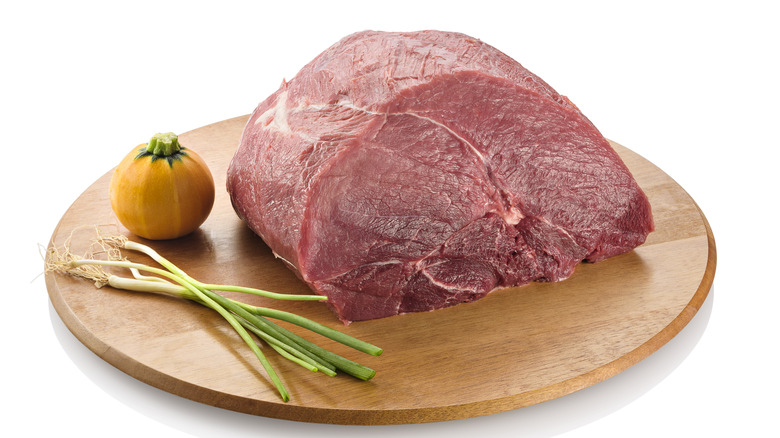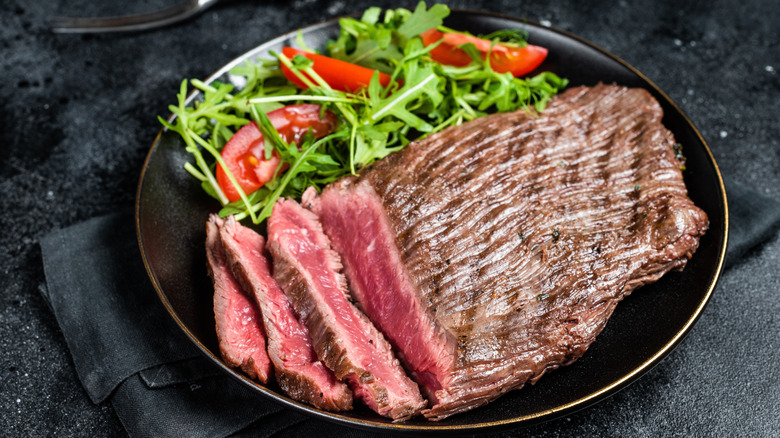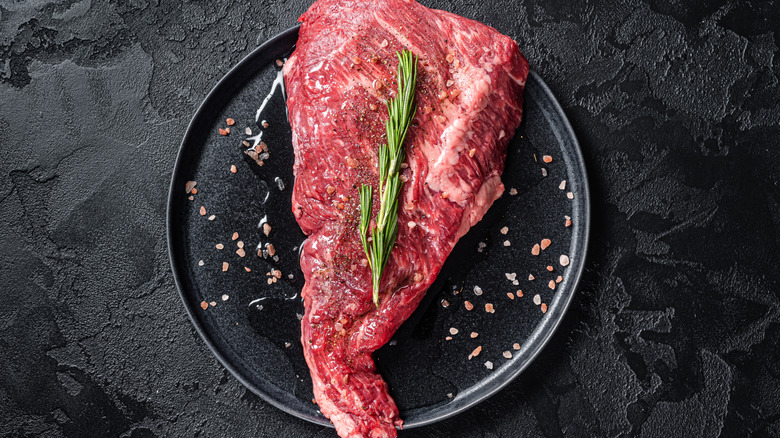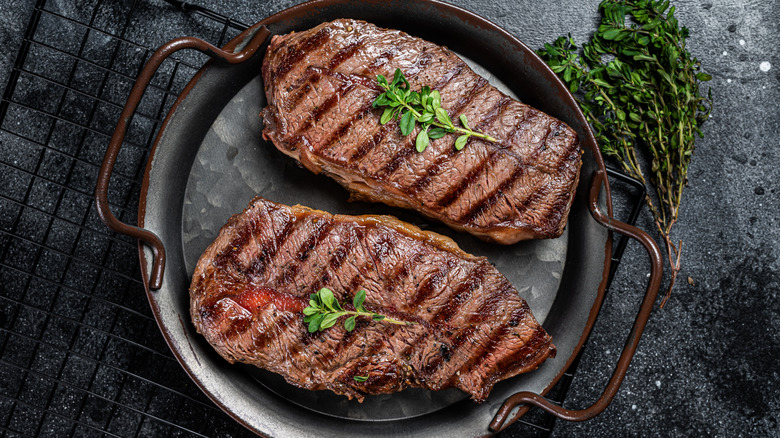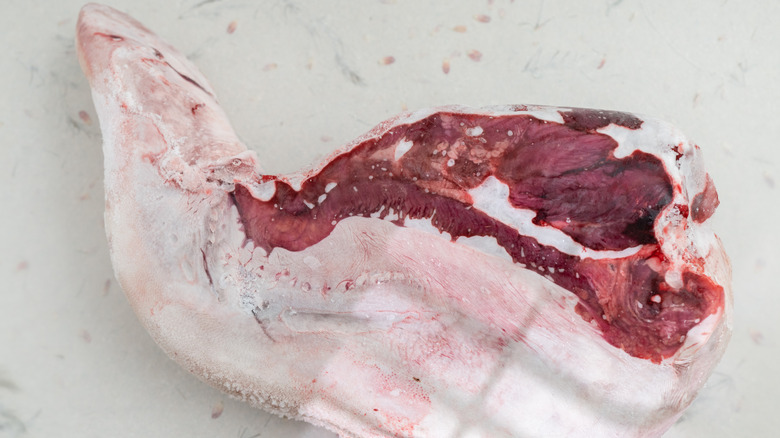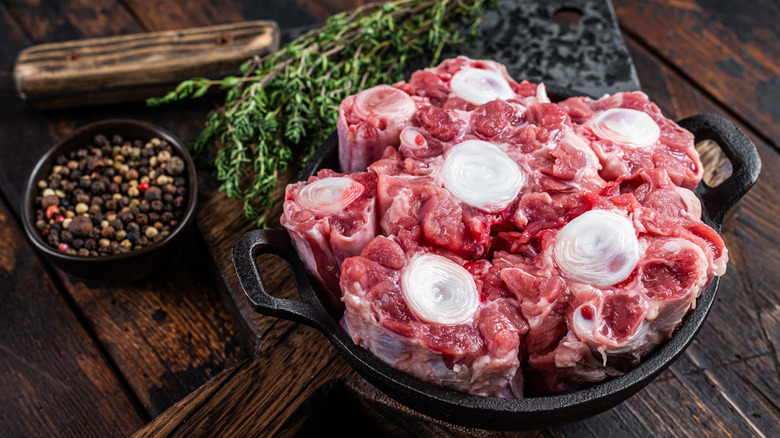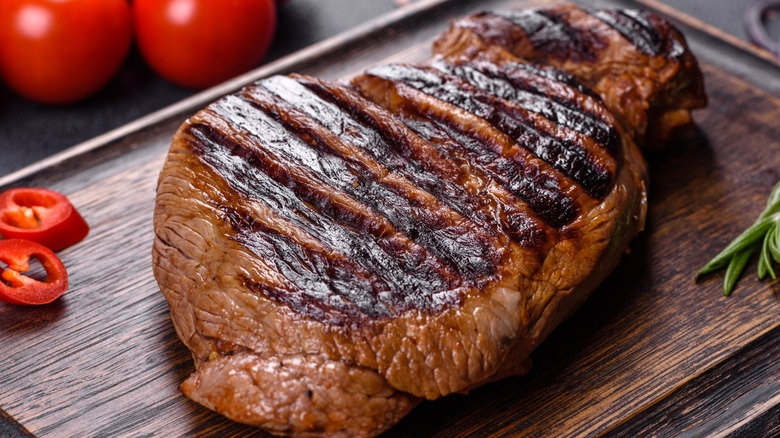Grill Masters Reveal The Most Underrated Cuts Of Steak You'll Wish You Knew About Sooner
Cuts of beef like ribeye, filet mignon, and porterhouse are all the rage and have been for a very long time. However, many underrated cuts of steak are worth paying attention to as well. They may not be the most common steaks on restaurant menus, but once you learn what they are and how to use them best something tells me you'll wish you knew about them sooner.
When trying to uncover the most underrated cuts of steak that are worth trying I consulted several experts on the matter. The first person I got insights from is Brian Smith. He's a Co-owner of The Butchery, a specialty butcher shop and artisan market in Orange County and San Diego, California. I also interviewed Chef David Rose, an Executive Chef for Omaha Steaks. Lastly, I got helpful tips from Chef Mike Saperstein. In addition to being a chef, he's a Co-owner at Sunshine Provisions, a premier high-end meat purveyor with local-to-national distribution.
All together, these experts shed some much needed light on lesser-known cuts of steak, and really, who better to ask about this topic than a butcher and a couple of chefs who specialize in steak? Keep reading to find out what they told me so the next time you find yourself selecting a cut of steak you can opt for something more adventurous without any hesitation.
Bavette steak (AKA flap steak or sirloin flap)
The term Bavette steak comes from France. Here in the United States, we call it a flap steak or a sirloin flap. However, regardless of what you call it, it isn't very common in the States. Executive Chef for Omaha Steaks, David Rose, told me, "It is a lean cut with a long, thin shape," and it's known for having a rich, beefy flavor, similar to that of a flank steak. He also said, "It's often referred to as 'the butcher's cut' as it's known to be reserved by butchers for their own enjoyment because it is comparably cheaper than other cuts, but is becoming increasingly known for its rich, deep flavors due to its high degree of very fine intramuscular fat (marbling)."
Chef Rose also told me that when cooked right, Bavette steak can be juicy. Unfortunately, it can be pretty tricky to cook though because it's so lean. Unlike a tenderloin or ribeye, it doesn't have a ton of fat, so if you cook it to temp above medium-rare or medium, it will likely turn out tough. In addition, Brian Smith said it takes marinades well, so that could help with tenderness. He also recommends slicing it against the grain for improved texture. According to the experts, Bavette steak is perfect for cutting steak tips and is best served over salad, alongside steak frites, or incorporated into fajitas, stir-fries, or stews.
Hanger steak
Hanger steak is another cut that is often referred to as the "butcher's cut," because they have been known to reserve it for themselves and not even offer it to customers. According to expert Chef Mike Saperstein, it's one of the best cuts of steak when cooked perfectly. Even so, he said most restaurants don't serve them because there is only one per cow (it comes from the diaphragm). David Rose confirmed: "With only one 1.5 pound hanger steak available in each 800+ pound animal, this cut is as rare as it is delicious."
Rose went on to tell me that many butchers consider hanger steak to be one of the most tender cuts: "It features deep intramuscular fat, or marbling, that, once prepared, provides a rich flavor that's undeniably juicy." It is also quite versatile. Brian Smith said, "Hanger steak loves the grill; sear it hard and fast." Then, it can be incorporated into various dishes or enjoyed solo. The experts recommend serving it with chimichurri sauce, or maybe just a bit of salt and pepper. However, if you want to experiment a bit more, tequila-marinated hanger steak should definitely be on your radar.
Denver steak
The Denver cut steak is rapidly growing in popularity. When I asked Chef David Rose about it, he said, "The Denver cut steak is screaming loud and proud with the great inter-muscular marbling of a ribeye and the beefy mouthfeel of a quality N.Y. strip. This boneless cut of steak from the shoulder of the cow is popping up in great steakhouses all over the world and for good reason... it's delicious!" Enough said, right?
The fact that the Denver steak comes from the shoulder (chuck roll or chuck flat) makes it more affordable. Even so, it has a super beefy flavor and, according to Chef Mike Saperstein, prime and Wagyu grades are tender. He recommends cooking it with a reverse sear in the oven or sous vide. Chef Rose recommends grilling it for about five minutes on each side, ensuring an adequate sear, and seasoning it to reflect your preferences. Overall, he said, "It's a great choice if you want something a bit different from the usual cuts."
Rib cap
If you've never had the pleasure of sinking your teeth into a rib cap before, you are in for a treat. According to Chef David Rose, it is a cut you should definitely be aware of. In fact, he said it is one of his all-time favorite steaks: "This highly premium top portion of the ribeye is known for its rich marbling and tenderness. It is full of fat, which provides a richer flavor once cooked, making the rib cap often the most flavorful part of the ribeye."
Chef Mike Saperstein elaborated on the cut itself by telling me, "There are two rib caps. The lifter meat and spinalis. They are often mistaken for each other." He went as far as to say, "The spinalis is the most flavorful and tender cut on the animal." He also told me it is extremely versatile and fares well when grilled or pan-roasted. Or if you want to take a tip from renowned celebrity Chef Michael Mina, you can try your hand at his butter-poached rib cap recipe.
Expert Brian Smith was also excited about the rib cap and said it was one of The Butchery's favorite cuts because it has "exceptional marbling that makes it extremely buttery, tender, and flavorful." It isn't the easiest to find all by itself though because it typically stays on the ribeye.
Teres major (AKA petite tender)
While not as tender as a filet or ribeye, the Teres major cut, or petite tender as it is sometimes called, is a fantastic pick when you are seeking a lean, tender steak that won't set you back a pretty penny. However, according to the experts, you won't find it sold at a lot of places because it's small and requires a considerable amount of work to separate. Plus, according to Chef Mike Saperstein, it's not as plentiful on the cow, so butchers and meat plants don't get much payoff for the added effort.
Chef David Rose told me that due to the Teres major cut coming from the shoulder and shoulder blade area, it is a relatively smaller tenderloin. Its restricted size is another reason many butchers don't carry it. Even so, Chef Saperstein thinks the Teres Major is a great tenderloin medallion substitute. It is also a fantastic alternative to the more expensive filet mignon steak, and it grills up nicely.
Sirloin cap roast (AKA Picanha or coulotte)
Whether you call it a sirloin cap roast, a picanha, or a coulotte, this steak should definitely be on your radar. It is cut from the top sirloin and it is very tender, beefy, and flavorful. According to Chef Mike Saperstein, "People that love a fatty cut really enjoy the crispy fat cap when cooked correctly." It may be a harder-to-find cut of beef, but Chef David Rose said it is "definitely worth the search and it's a favorite among Omaha Steaks master butchers."
Intrigued yet? You should be. Chef Rose told me that the sirloin cap roast is "considered the most delectable cut for Brazilian steakhouses and becoming increasingly popular in the U.S." There are many ways to use a coulotte, but Rose likes to make a roast, and his "favorite way to cook this popular roast is on the grill! The smokey-charred notes on the picanha are second to none when coming off of the direct flame on a grill." You can also get spectacular results in an oven or smoker, he likes to mix it up. Brian Smith recommends this cut for home cooks, as well. In addition to roasting, he says it is also good for slicing into steaks and grilling.
Beef knuckle (AKA round tip, sirloin tip, or tip center)
While called a beef knuckle, this cut is actually part of the round, which is what we call a cow's hindquarters. More specifically, Chef David Rose said, "The knuckle is found on the front end of the rear leg," between the top and bottom rounds. In addition to being called a beef knuckle, you'll also find it called round tip, sirloin tip, tip center, and more.
Beef knuckle is exceptionally lean and all the experts agree, it is a great cut for making soups and stews. The beef knuckle is also well-suited to grinding and braising. Brisket may be the go-to cut for braising, but if you're looking for an inexpensive cut for tender braised beef, the round tip makes a wonderful alternative. When cooked properly, it becomes juicy, tender, and undeniably drool-worthy. If you want to give it a go, just remember to look for it by its various names so you don't accidentally pass it by.
Flank steak
Most of us have heard of a flank steak before, but according to Chef David Rose, "It's often overlooked because it's a tougher cut with almost no fat." It comes from the lower abdomen region of a cow and is very thin, long, and lean. As a result, Chef Mike Saperstein told me it is easy to overcook. Even so, it's worth giving it a try, you'll just have to proceed with caution and give it all the care and attention it deserves.
Flank steak has a strong flavor and Chef Rose believes it has the potential to taste fantastic when cooked right. He recommends marinating it and cooking it quickly on high heat. Brian Smith agreed: "This cut takes marinade well and likes a quick sear, and must be sliced against the grain." When it comes to marinades, there's no limit to what you can use with a flank steak. If you like a bit of kick, wasabi flank steak could be right up your alley. Or, for something with a brighter taste, a tropical marinated flank steak bánh mì is sure to be a winning recipe. Thanks to its long, thin shape, rolled flank steak stuffed with tasty ingredients like cheese, bacon, and veggies is also a possibility.
Tri-tip steak
Tri-tip is another cut of steak most people have heard of, even if they haven't had a chance to enjoy it. Easily recognizable by its triangular shape, the tri-tip comes from the bottom of the sirloin. Chef David Rose told me tri-tip is rich, meaty, low in fat, and super flavorful.
Chef Rose also said, "Tri-tip cooks like a tender steak but slices like a brisket," so it's an excellent pick if you don't have time to do a proper brisket but still want a similar cook. "It can be smoked, barbecued, grilled, or roasted, but it's always best when cooked to a nice medium rare," said Chef Rose. Chef Mike Saperstein agrees tri-tip is good for smoking and also recommends hard marinating, but because it can be a bit tough. When grilled, he said it must be tenderized first.
Even if tri-tip isn't popular where you live, it"is extremely popular in the Western U.S., especially in California," said Brian Smith. He told me it is known for its rich texture and flavor, and also has cultural significance. For example, "A slow-cooked Santa Maria-style tri-tip over a wood-fired BBQ is iconic in California."
Flat iron steak
There are a couple of reasons why flat iron steak is not super well known or enjoyed. First, Chef Mike Saperstein told me, "The steak is tender but can be an inconsistent cut with a seam running through it." It isn't the easiest to cook either because it is a thinner cut. Brian Smith also revealed that the skirt steak, which is similar in shape, overshadows it because it has superior flavor and texture.
Regardless of why flat iron steak gets overshadowed by other cuts, it is quite tender, has a rich beefy taste, and has good marbling. It's also more affordable than other cuts. In fact, Chef David Rose said, "It's an excellent choice that won't break the bank but will still satisfy your steak cravings. When it comes to getting the most bang for your buck without compromising on flavor, I personally love a flat iron steak." So, if you want to branch out from a skirt steak but don't want to stray too far, the flat iron steak is waiting.
Beef cheek and beef tongue
Just as you would expect, beef cheeks come from the face of a cow. Chef David Rose told me, "It's a tougher cut of meat on its own, due to the excessive use of the muscle, but tougher cuts are usually incredibly flavorful when properly prepared." In his opinion, slow cooking is the way to go. When cooked in this manner, he said "beef cheeks melt in your mouth with a delicious, rich flavor." For the best results, he recommends cooking it on low for six to eight hours. However, it can be hard to clean if you aren't familiar with the process, so Chef Mike Saperstein said you should always buy beef cheek pre-cleaned to make handling and cooking easier.
Also aptly named, beef tongue is exactly what you think it is. It may not be super popular in the U.S., but "beef tongue is a unique cut enjoyed in many cultures," said Brian Smith. Similar to beef cheek, it is best when slow-cooked. Chef Rose told me it is a labor of love for home cooks because it takes quite a bit of time to prepare. However, "When properly prepared, beef tongue is extremely tender, with both lean and fattier parts of the meat to enjoy. It's great for home cooks that want to step out of their comfort zone and experiment with new recipes." He likes it in tacos.
Oxtail
The oxtail is quite literally the tail of a cow that has been cut into sections. While many home cooks haven't ventured into the world of cooking oxtail, it's one of Mike Saperstein's favorite cuts. He said it is, "Super flavorful and filled with collagen and gelatin." According to Brian Smith, oxtail used to be regarded as a lesser cut, but he confirmed: "It's now popular for its rich, gelatinous texture and robust flavor."
Slow braises and low, slow smokes are oxtail's friend. In fact, Chef Saperstein said it is currently gaining popularity in the smoking world. It is also delicious turned into Jamaican braised oxtail stew. Chef David Rose told me Jamaican oxtails are his favorite recipe for this cut. However, he does it with a French twist. He braises them with "thyme, scotch bonnet pepper, a splash of great red wine, and beef stock." Then, he finishes them with butter and lima beans and serves them on top of fluffy Jamaican rice and peas. When done, he said you should be able to easily pick the meat of the bones.
Chuck eye
Last but not least on our list of underrated cuts of steak you'll wish you knew about sooner is chuck eye. Like many of the other steaks featured, it is known for being tender and having a rich flavor, so it shouldn't be overlooked. You don't have to worry about it being an actual eye either. Chef David Rose explained: "Chuck eye is a cut of beef that comes from the shoulder of the cow, near the fifth rib, which is also known as the chuck primal."
Admittedly, Chef Mike Saperstein told me it isn't very versatile. However, Chef Rose had a different opinion. He recommends a low and slow cooking method, but he said, "It can also be cooked using a higher heat like you would use for a ribeye or other prime cuts." So, it is a bit more versatile than some of the other cuts you find above. He did say chuck eye isn't the easiest cut of beef to find, but that's because you only get two from each cow. Even so, it is a budget-friendly option, and Brian Smith told me it is often called the "poor man's ribeye," so it's a great substitute for any ribeye recipe that looks too pricey for your budget.

